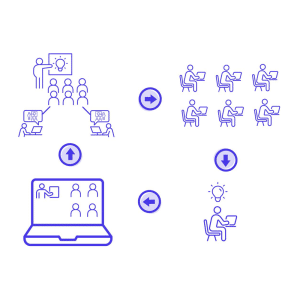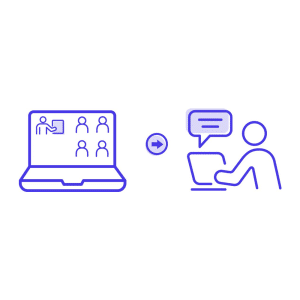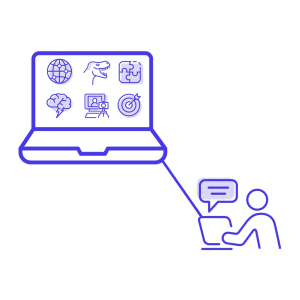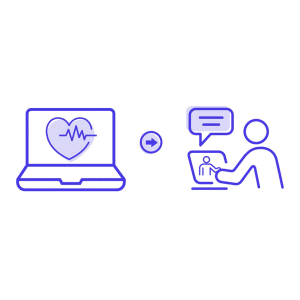
Jamie Turak is an Education Content Manager at Class. He's passionate about storytelling and helping to make education more accessible.

Jamie Turak is an Education Content Manager at Class. He's passionate about storytelling and helping to make education more accessible.

This blog post teaches how to implement and scale online learning that makes sense for your school or district. Understand new models and best practice tips.
8 minute read
In a post-pandemic world of education, a fundamental shift in schools’ instructional modeling is becoming more apparent.
The pandemic revealed that past learning modalities do not meet every student’s flexible learning needs. We also learned the importance of thoughtful implementation to make virtual learning successful. Unfortunately, the pandemic’s rapid quick-fix response left schools, students, and teachers disoriented and rushed to find viable solutions. But we learned valuable lessons about what successful online learning implementation looks like.
To be impactful, online learning needs strategic design. Virtual options can address significant school challenges, like unprecedented staffing shortages and lack of social-emotional services. The challenge can inform the implementation strategy, so it’s crucial to identify your primary goals.
Today, the technology exists to create simple and sustainable–but deeply impactful–transformations in how K-12 schools and districts design and deliver education. Thoughtful online learning implementation can provide the impact schools need, like scaling teaching roles across districts, expanding curriculum offerings, boosting engagement, and offering more robust wellness and trauma student supports.
Synchronous learning is our most familiar educational model. It includes students learning together at the same time. Traditionally, synchronous learning has been brick-and-mortar, but online education has changed that.
An online synchronous instructional model enables students in different locations to learn together in the same classrooms with one or multiple teachers. Learners may join the class together in the same room or from another school or home.
Until the pandemic, most online instructional models followed asynchronous designs. Lessons are self-paced and set within a given time frame, where students access materials. There is minimal or no direct verbal instruction from teachers, although students can contact them for support. Asynchronous learning materials include curriculum support items like rubrics, multimedia content, readings, and other downloadable resources or activities.
Hybrid or blended learning offers a dynamic multi-modal approach to education design. Rather than a “this or that” approach, educators combine synchronous, asynchronous, and in-person modalities to meet the complex and emergent needs of schools, students, and teachers.
Combining modalities creates unique solutions to complex problems and promotes educational access, equity, and efficacy. Rather than focus on how virtual and in-person learning are different, schools have the opportunity to expand what is possible. An uncertain future requires flexible solutions–and hybrid learning models help.
The pandemic illuminated factors that made educators rethink why online synchronous education is essential–and how blended learning can leverage it alongside traditional in-person offerings.
For example, standard educational models work well for some students but not all. Namely, MTSS models have, until recently, been structured with an assumption that most students perform at expected levels of success. In reality, more than 50% of students in U.S. schools struggle to keep up with grade-level expectations, which has been increasing since 2019.
Social distancing mandates from the pandemic forced educators to find creative ways to teach at a distance. While an extraordinary logistical and social-emotional challenge, this process revealed new possibilities to improve access and equity in education, which remain a focus in education today.
Online synchronous learning doesn’t have to be all-or-nothing, and there is no one-size-fits-all approach.
Implementing online learning plugs gaps in traditional K-12 programs to mitigate district-wide challenges. When considering the best implementation model for you, identify your school or district’s major problem areas.
 Staffing shortages
Staffing shortagesHow can I deal with teacher staffing shortages and attract teachers and staff to my district?
Connecting classrooms across schools and districts via a Shared Synchronous Instruction (SSI) model allows schools to expand and scale teacher support and instructions. For the SSI model, teachers use a blended model of both online synchronous and in-person to reach a wider audience of students shared across multiple instructors. This model is designed to help fight teacher shortages and staffing issues.

How can I ensure online and virtual learning programs provide a rigorous, rich, and engaging learning environment?
Enriched Online Learning (EOL) brings traditional strategies like live peer collaboration, intentional instructional components, and real-time supports to the virtual classroom. The EOL model enriches online learning beyond a video conferencing style. Students thrive with a balance of self-directed, group, and guided work for schools and districts already teaching sizable online enrollments.

How can I connect my classroom or school the community for more equitable learning opportunities?
Online synchronous learning provides schools and districts unique access to learning opportunities outside brick-and-mortar schools. An Instructional Choice enriches blended learning systems with applied learning–to connect classrooms with the world at large. Virtual learning can expand learning beyond classroom walls and introduce students to their community, and discover museums, cultural institutions, industries, and workplaces.

How can I provide more robust social-emotional, mental health, and wellness supports to students?
The Virtual Whole-Child Support model is used to scale mental health and student services. The future of education is ensuring every student has academic and emotional support. This model gives students unprecedented access to extra-instructional help, care, and practitioners.
 Learning gaps inside school
Learning gaps inside schoolHow can I transform my school and think beyond existing staffing, classroom, and opportunity structures?
Fundamentally transform time and place constraints of learning with an Adaptive Immersion model. Blended learning environments create flexibility for students, where they can learn from home, a lab within their school, or onsite at a workplace. Students are offered multiple methods to connect for instructional support, and online learning classes are enriched with live learning, project-based options.
First, identify unique challenges faced by your school or district. Implementation will look different depending on your needs, circumstances, and abilities. And it’s critical to understand the aggravating factors before you start.
Next, based on your assessment, calibrate the implementation model that makes the most sense for you. Finally, anticipate iterations and redesign efforts to be central to your efforts. Management, systems, training, and curriculum design will undergo fundamental changes before successful school and classroom transformations.
Here are the best practices to consider for each model from the earlier section to drive change across your broader educational strategy.
The future of K-12 education is a blend of brick-and-mortar offerings with strategic online implementations that use technology to scale and make learning accessible, impactful, and plug holes in traditional systems.
Class and Zia Learning have developed these implementation models to help your school or district think about their future learning design.
Class leverages emergent technologies to enhance digital learning, offering an engaging and supportive online learning platform for schools and institutions globally. And it integrates seamlessly with Zoom, so you don’t have to worry about building your program from the ground up.
If you want to implement online learning strategically at your school or district, sign up for a demo today and see how Class works for you.

Jamie Turak is an Education Content Manager at Class. He's passionate about storytelling and helping to make education more accessible.

Jamie Turak is an Education Content Manager at Class. He's passionate about storytelling and helping to make education more accessible.
Get our insights, tips, and best practices delivered to your inbox

Sign up for a product demo today to learn how Class’s virtual classroom powers digital transformation at your organization.

Features
Products
Integrations